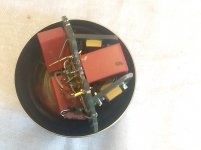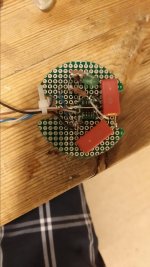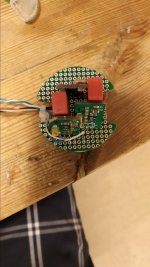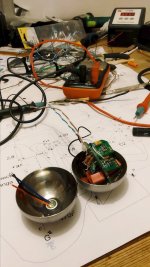Hmm, could not meet my own plan and now on mini vacation out of town... but on a return touch & go, I found the new FPGA between the morning paper ;-)
//
//
I don't know -- methinks a certain amount of pride is in order. 3-dimensional building is always much more difficult.
You've packed a heckuva lot of functionality into a very small space! I'm impressed. 😀
Cheers
You've packed a heckuva lot of functionality into a very small space! I'm impressed. 😀
Cheers
Thanks! Need som encouragement prior to launch 🙂 will there be smoke... w'll know tomorrow... tonight inspection ans corrections...
//
//
Attachments
Last edited:
Flipped the switch. Green light from LED 🙂 no smoke :-D
On the EVM board there are measuring points on the input to the AD converter. I measure 1,91 vs 2,31V there.
From the MIC I see 4,08 vs 3,76. So 320mV.
Knocking the mic gives some reading in AC mode on the AVO ;-)
//
On the EVM board there are measuring points on the input to the AD converter. I measure 1,91 vs 2,31V there.
From the MIC I see 4,08 vs 3,76. So 320mV.
Knocking the mic gives some reading in AC mode on the AVO ;-)
//
Attachments
Last edited:
The coax output on the EVM board says AES/EBU - I wonder if the coax-in on my Roland QUAD-CAPTURE can receive that??
Nothing on the VU meters...
//
Nothing on the VU meters...
//
All voltages OK to EVM. EVM board clipping LED for the connected channel blinks shortly at power on. Everything is powered on at the same time.
//
//
The coax output on the EVM board says AES/EBU - I wonder if the coax-in on my Roland QUAD-CAPTURE can receive that??
Nothing on the VU meters...
//
75 ohm AES/EBU (AES3) is very similar to S/PDIF, but the channel status word will be different. That includes the infamous copy bits, those don't exist in the professional version.
What is the range of the meters? 0 dBFS is over 130 dB, is there any chance that you are recording something but it's too weak to move the VU meters?
Last edited:
OK - so should work. Haha - that could be possible 🙂 I have to knock it harder.
I'll check that.
//
I'll check that.
//
For the DIT config Table 16. DIT4192 Data Format Selection, I suppose the setting should be Left Justified and not i2s which is the other option...
I see 20mV TRMS on my AVO hitting the mic so some 30db down should read on my 60 dB range VU meters.
So something on the digital side of the EVM...
//
I see 20mV TRMS on my AVO hitting the mic so some 30db down should read on my 60 dB range VU meters.
So something on the digital side of the EVM...
//
Last edited:
Flipped the switch. Green light from LED 🙂 no smoke :-D
On the EVM board there are measuring points on the input to the AD converter. I measure 1,91 vs 2,31V there.
From the MIC I see 4,08 vs 3,76. So 320mV.
Knocking the mic gives some reading in AC mode on the AVO ;-)
//
I'm surprised the voltages from the MIC are so high. I assume that 4.08 V and 3.76 V refers to the voltages coming out of the OPA1612, is that correct? If so, which of the two is coming from the diode stack and which from the microphone? What voltage do you see at the drain side of the EM273?
1) Diod stack (between diod and 2,8k)-Ground: 6,4V
2) Signal out-Ground:1,97
3) D(rain)-Ground:2,98
Have a hunch something is not quit correct... 2) and 3) should be the same, right...
//
2) Signal out-Ground:1,97
3) D(rain)-Ground:2,98
Have a hunch something is not quit correct... 2) and 3) should be the same, right...
//
3) should be greater than 2), but I expected 3) to be around 5 V. 2) is about right, but 1) is way too high. None of them are approximately equal to the voltages at the op-amp outputs that you reported earlier, while those are just buffered versions of 1) and 2).
- Home
- Source & Line
- Digital Line Level
- Fixed gain field recorder?





